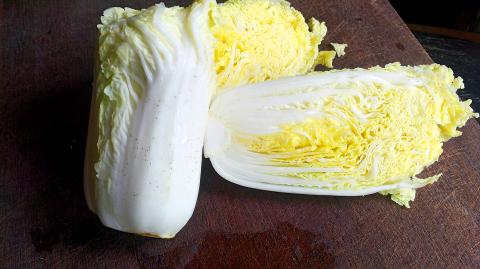Back in December 2015, I wrote about a vegetable (Taipei Times, Dec. 26, 2015) that went by the cutesy name of “baby veg” or wawacai (娃娃菜). It is a member of the Brassica family (juncea Coss. var. Gemmifera to be specific) and is related to mustard greens, though with a much gentler flavor. At the time I was a bit confused, as the name is also used to refer to miniature versions of the Chinese cabbage, and while related through common associations with the Brassica family (though in this case Brassica rapa subsp. pekinensis), it couldn’t look or taste more different.
Chinese cabbage is a mainstay of much Asian cooking, with a taste and texture profile that is quite distinct from headed cabbage (comprising several cultivars of Brassica oleracea) that is such a stalwart of European cuisine. It looks quite different as well, being elongated rather than round, and there is even a theory that it is not really a cabbage at all, with a family history that involves dubious relations with the turnip.
Chinese cabbage is also known as napa cabbage, a name that some say derives from its cultivation in the Napa valley of California, while others insist that the name is a transformation of “nappa,” a regional colloquial Japanese term referring to vegetable leaves generally. In Australia it is often referred to as “wombok.” As the vegetable is not regarded as particularly Chinese within Asia, and napa and wawacai both invite confusion, I think wombok does the best job of referring to this little gem of the vegetable kingdom.

Photo: Ian Bartholomew
Wombok is now widely available outside Asia and is prized for its sweetness and tenderness, along with a much subtler flavor than headed cabbage. It can be eaten raw, and the leaves, when shredded, are perfect for salads and slaws. The firmer stem section is excellent in soups and braises, providing crunch if lightly cooked, or deepening flavor when left to gradually cook down.
The miniature version of this cabbage, which uses the moniker of wawacai, exaggerates the aesthetic and culinary aspects of its larger manifestation. They are perfect mini cabbages that can be eaten whole or halved, and look like a natural version of the famous Jadeite Cabbage with Insects (翠玉白菜) that is probably seen by every visitor to Taiwan’s National Palace Museum.
While they can be used in all applications that their full grown family members might be found in, their more delicate flavor suits them particularly to gentle preparations such as poaching.

Photo: Ian Bartholomew
As with other types of cabbage, or indeed vegetables generally, wombok has many health benefits, particularly in being a low calorie source of plentiful quantities of dietary fiber, vitamins (notably vitamin K which is said by some to improve defenses against dementia) and minerals (particularly calcium and magnesium for bone health).
The health conscious take comfort in as many of these claims as they want, but ultimately, the appeal of miniature wombok for many is that is looks really cute on the plate. It actually tastes really good as well, and that is a big plus. Like cabbage, they keep well in the fridge, but are nevertheless best eaten fresh.
Recipe (serves two)
Foil steamed sea bass with poached wombok served over fragrant spelt
Minitature wombok works really well poached, and the combination of sea bass with just a hint of piggy saltiness from the salt pork makes for a delicious combination. The dish can be quite as easily served on white or herbed rice, but alternative grains are all the rage right now and the creaminess of spelt slowly cooked in stock gives a chewy yet unctuous undertone to the fish. As cooking with stock is such a major part of this recipe, homemade is definitely preferable.
Ingredients
For the fish:
1 piece sea bass, skin on, approx. 300g
1 tbsp extra virgin olive oil
1/2 tsp sea salt
1/4 tsp black pepper
4 sprigs fresh thyme
2 cloves garlic, minced
6 cherry tomatoes
For the wombok:
500ml vegetable stock, homemade
1 slice salt pork (a piece of rind will do the trick)
2 miniature wombok
For the spelt
1/2 cup pearled spelt
500ml vegetable stock
pinch of salt
50g roasted bell pepper, roughly chopped
handful of pine nuts, toasted
20g white onion, finely chopped
10g Italian parcel, finely chopped
Directions
1. Preheat the oven to 190c.
2. Wash the fish and pat dry. Place it skin-side down on a large sheet of foil. Season with salt and pepper.
3. Heat the olive oil in a skillet and fry the garlic until fragrant. Throw in the tomatoes and cook for a couple more minutes until the tomatoes start to soften.
4. Pour the mixture over the fish and fold the foil into a parcel, pressing hard along the seams to ensure a good seal.
5. Place the parcel on a middle shelf in the oven and bake for about 15 minutes, depending on the thickness of the fish. Unseal and check doneness. If not cooked through, reseal and bake for a couple more minutes.
6. While the fish is baking, bring the stock and salt pork to a boil. Halve the miniature wombok and immerse in the stock and cook at a low simmer for about 20 minutes, until the vegetable is easily pierced with a skewer and the stock is thick and creamy.
7. Rinse the spelt and place in a small pot, adding enough stock to cover by 1cm. Season with a pinch of salt. Bring to a boil then reduce to a robust simmer. Keep the remaining stock hot, as you would for a making a risotto, adding liquid to the spelt when the liquid begins to dry out. Cook for about 20 minutes, adding stock as needed until the spelt is tender and a little creamy.
8. Add the chopped bell pepper, onion, pine nuts and parsley. Season with salt and pepper according to taste.
9. Serve the fish over the spelt. Serve with the wombok that has been dressed with a little of the cooking liquid.
Ian Bartholomew runs Ian’s Table, a small guesthouse in Hualien. He has lived in Taiwan for many years writing about the food scene and has decided that until you look at farming, you know nothing about the food you eat. He can be contacted at Hualien202@gmail.com.

Not long into Mistress Dispeller, a quietly jaw-dropping new documentary from director Elizabeth Lo, the film’s eponymous character lays out her thesis for ridding marriages of troublesome extra lovers. “When someone becomes a mistress,” she says, “it’s because they feel they don’t deserve complete love. She’s the one who needs our help the most.” Wang Zhenxi, a mistress dispeller based in north-central China’s Henan province, is one of a growing number of self-styled professionals who earn a living by intervening in people’s marriages — to “dispel” them of intruders. “I was looking for a love story set in China,” says Lo,

It was on his honeymoon in Kuala Lumpur, looking out of his hotel window at the silvery points of the world’s tallest twin skyscrapers, that Frank decided it was time to become taller. He had recently confessed to his new wife how much his height had bothered him since he was a teenager. As a man dedicated to self-improvement, Frank wanted to take action. He picked up the phone, called a clinic in Turkey that specializes in leg lengthening surgery — and made a booking. “I had a lot of second thoughts — at the end of the day, someone’s going

In the next few months tough decisions will need to be made by the Taiwan People’s Party (TPP) and their pan-blue allies in the Chinese Nationalist Party (KMT). It will reveal just how real their alliance is with actual power at stake. Party founder Ko Wen-je (柯文哲) faced these tough questions, which we explored in part one of this series, “Ko Wen-je, the KMT’s prickly ally,” (Aug. 16, page 12). Ko was open to cooperation, but on his terms. He openly fretted about being “swallowed up” by the KMT, and was keenly aware of the experience of the People’s First Party

Standing on top of a small mountain, Kim Seung-ho gazes out over an expanse of paddy fields glowing in their autumn gold, the ripening grains swaying gently in the wind. In the distance, North Korea stretches beyond the horizon. “It’s so peaceful,” says the director of the DMZ Ecology Research Institute. “Over there, it used to be an artillery range, but since they stopped firing, the nature has become so beautiful.” The land before him is the demilitarized zone, or DMZ, a strip of land that runs across the Korean peninsula, dividing North and South Korea roughly along the 38th parallel north. This